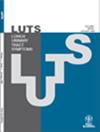Urotherapy and biofeedback resistant dysfunctional voiding: How to deal with?
Abstract
Objectives
To analyze the management strategies in the children who had treatment-resistant dysfunctional voiding (DV).
Methods
Among 75 children with DV who underwent pelvic floor biofeedback therapy (BF) between 2013 and 2020, 16 patients (14 girls, 87.5%) with a mean age of 9.81 ± 2.53 years that showed incomplete clinical response following urotherapy and initial BF sessions were retrospectively reviewed. The demographic and clinical characteristics, DVSS, and uroflowmetry parameters were recorded before and after the initial BF sessions. Subsequent treatments after initial BF and clinical responses of patients were noted.
Results
Clinical success was observed in one patient by addition of an anticholinergic and in three patients with combination of salvage BF sessions and anticholinergics, whom had predominant overactive bladder (OAB) symptoms. The success rate of TENS alone and in combination with other treatment modalities was 88.8% (8/9 patients). In addition, salvage BF sessions (range 2 to 3) enabled clinical success in five (50%) of 10 cases as a combination with anticholinergics or TENS. In case of incomplete emptying without OAB, adequate clinical response to Botulinum-A was observed during an average follow-up of 29 months in two boys who did not respond to alpha-blockers, even though one required repeat injection after 10 months. The total clinical success rate was 87.5% (14/16 patients) after a median follow-up of 24 months. VV-EBC and Qmax increased by a mean of 30.89% and 7.13 mL/min, respectively, whereas DVSS decreased by a mean of 8.88 points and PVR-EBC decreased by a median of 19.04%.
Conclusions
Our findings showed that clinical success in resistant DV was achieved by various combination treatments in the majority of children. However, a small group may still have persistent, bothersome symptoms despite multiple treatment modalities.

 求助内容:
求助内容: 应助结果提醒方式:
应助结果提醒方式:


